G
Guest
Guest
I fled south at the bitter end of February, timing my escape between snowstorms. The truck had been parked atop the driveway glacier for weeks, so packing tools, gear and boat was an ordeal.
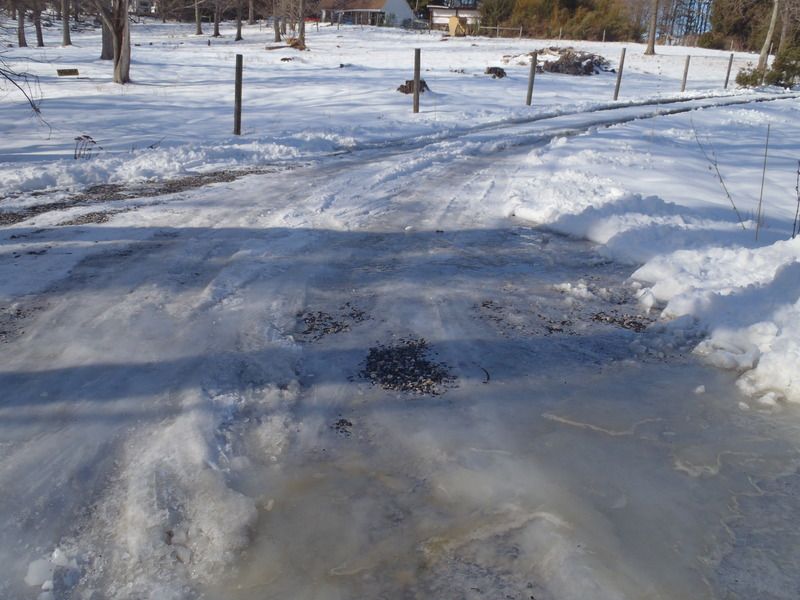
I arrived at my home base in the pine barren swamps of NC’s South River to find a more fluid situation. The culvert across the road in is blocked and flooded. I splashed through, unloaded the truck and returned in full-Farmersexual outfit; overalls and muck boots, with saws, rakes, hoes, clippers and other implements loaded into the Gator. With a fair tasty beer.
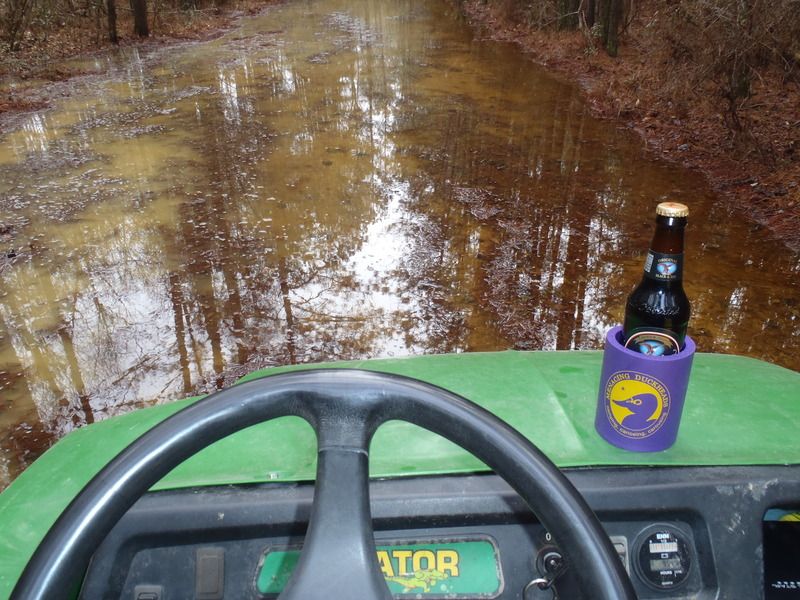
I gave up four times trying to unplug that dang culvert. And went back 5 times. I got a little drainage going, but the top of the culvert was still 4 feet underwater. I could just barely hook some obstructing piece of metal debris lodged at the culvert opening, which itself took a while to even find, but I couldn’t get the obstruction near the surface.
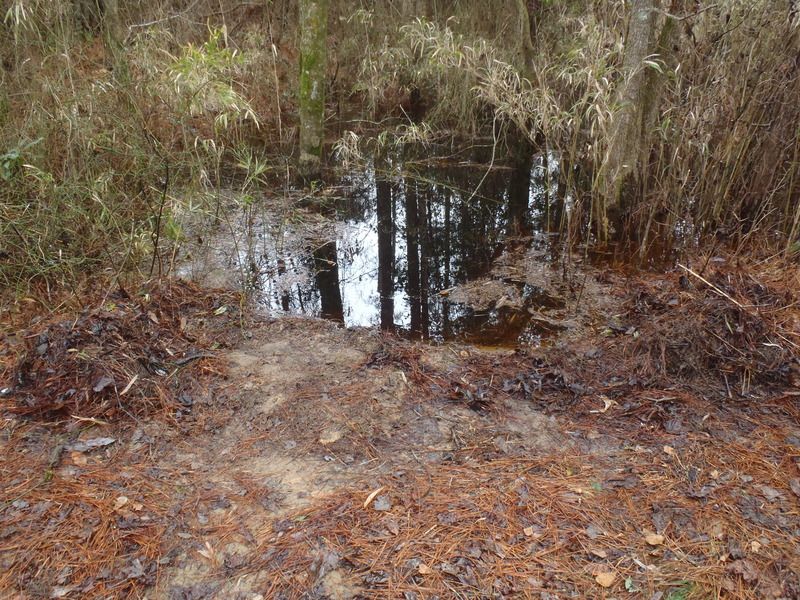
OK, I gave up five times. That last time I was bushed, utterly defeated and a good 10 steps back to the Gator when…it flushed.
This end of the culvert had been a dribble.
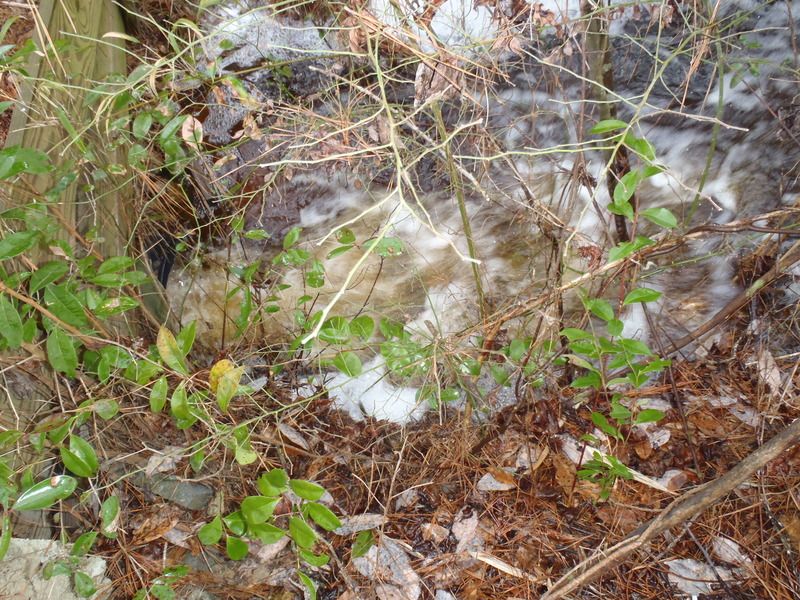
Too freaking cool. I can sit and spend a whole day watching the tide go in and out. Might as well sit a spell and watch the swamp drain. Unlike the tides I may never get that opportunity again. That blocked culvert had flooded and backwatered 50 acres and took a long time to drain. Days.
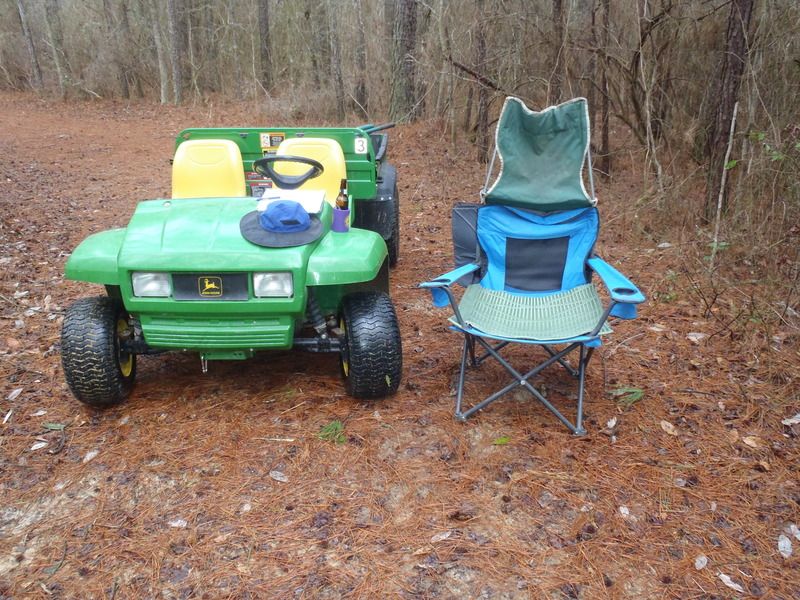
Entryway passable there followed a few weeks of, well, playing on the farm if you will, with the usual late night (for me that is any time after dark) shenanigans in the shop. The traditional scrap wood birdhouse, puzzled together and constructed using angle-cut scrap wood and zero new saw cuts, except the entry hole. This time even the entry hole was there. My friend Dave never threw away even a tiny scrap of wood, as the lumber building will attest.

Into my farmhand week paddling pal NC Willy came by for a visit and dueling Tacoma sleepover, and we spent some time in the trees.
Spade bit circle drilled through the bark and cambium.
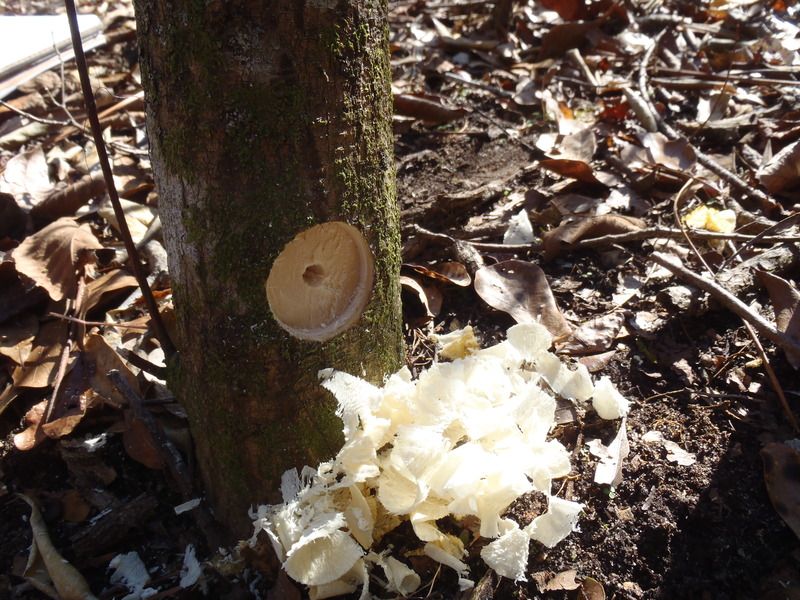
Chiseled oval and inlaid with a semi-precious cabochon.
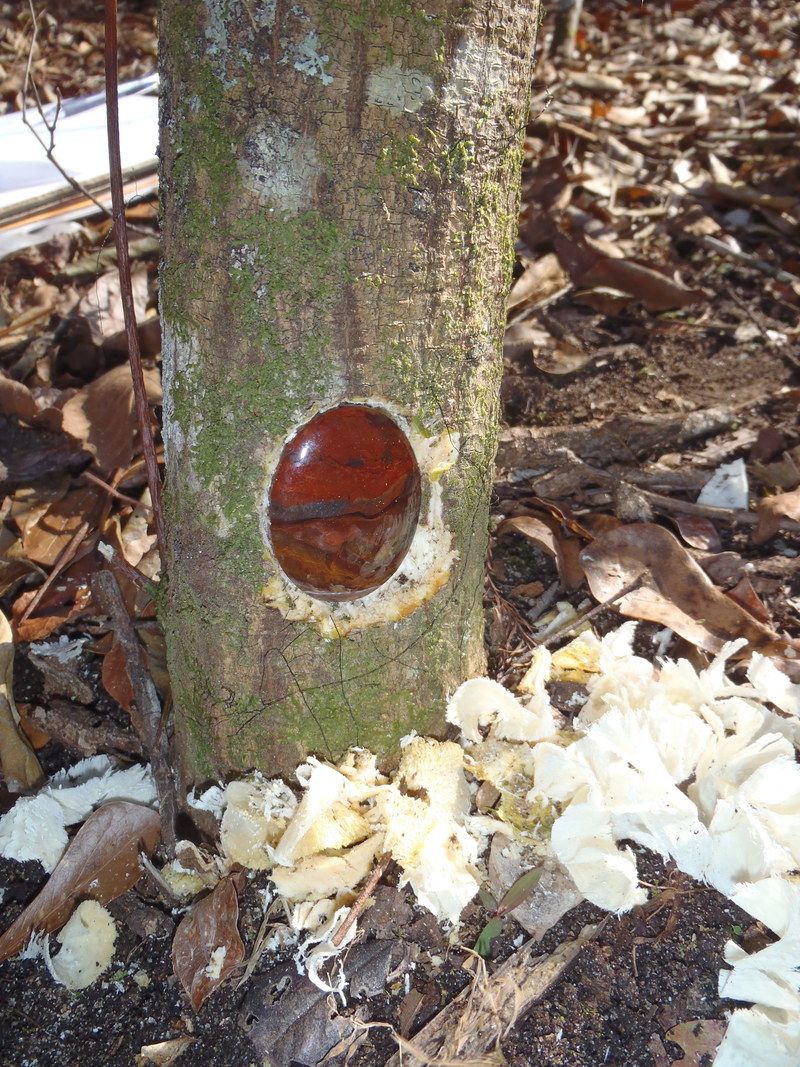
Add a hose clamp and a little rubber stopper spacer, so the tree has room to grow a natural bezel around the stone, and the growth stresses don’t crack the agate.
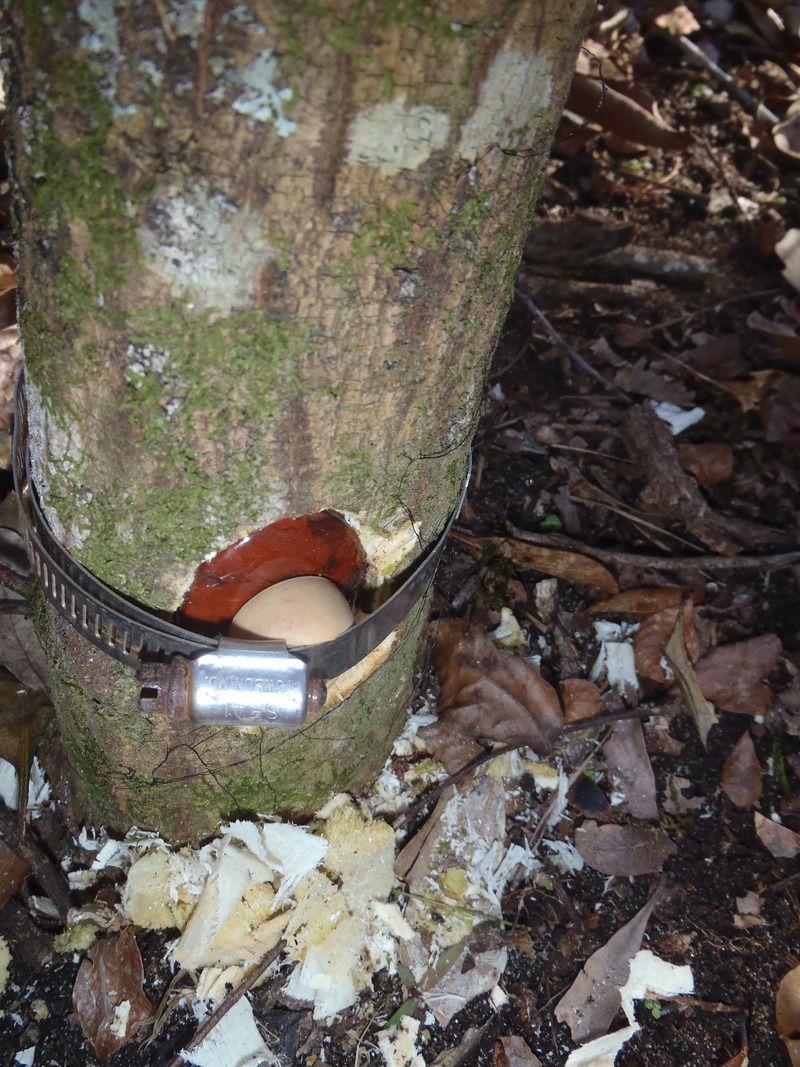
Wait a year or three, remove the hose clamp, and wait a few more years. Dig it up, roots and all (the root structure is the coolest part). Wait a few years while it dries. Strip the bark, shape and sand it into whatever it wants to be – walking stick, sculpture, pipe bowl. Prettiest gear shift knob ever on 20 year’s worth of manual transmissions.
Makes for a nice multi-year project.
Beyond draining swamps. constructing scrap wood puzzles and sticking and stoning - in various definitions – there was plumbing, electrical and fence to work to attend to, and betwixt and between farm work even some canoe outfitting. It had for months been too cold at home to do much boatwork, so I brought some with me. Gawd bless a well equipped shop with ample carport space.

A word on the early March weather in eastern NC. In the space of three days I used three different sleeping bags, a zero degree Wiggys, a 20 F down and a 30/50 down flip. It went from dang cold at night
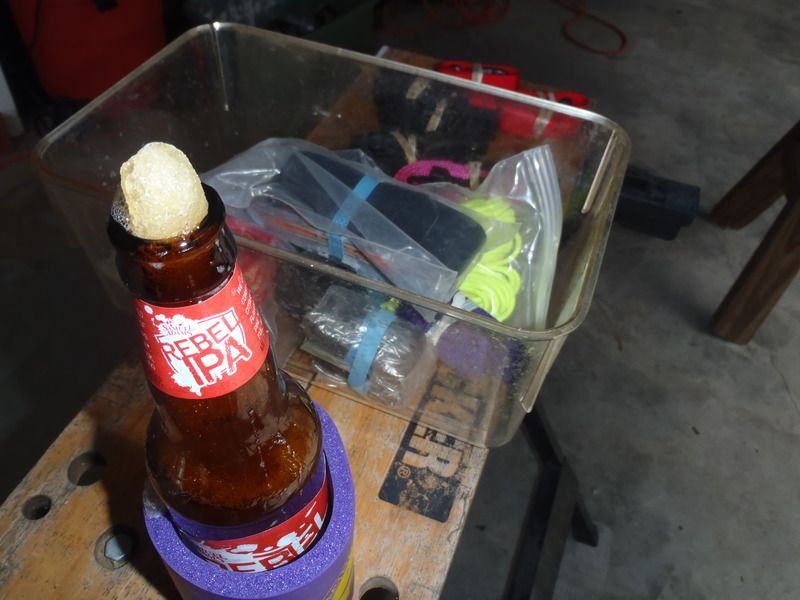
To shorts and tee shirt weather in 3 days.
But, eventually, you can’t keep me down on Maggies Farm no more. Time to pack up gear and plan a trip.
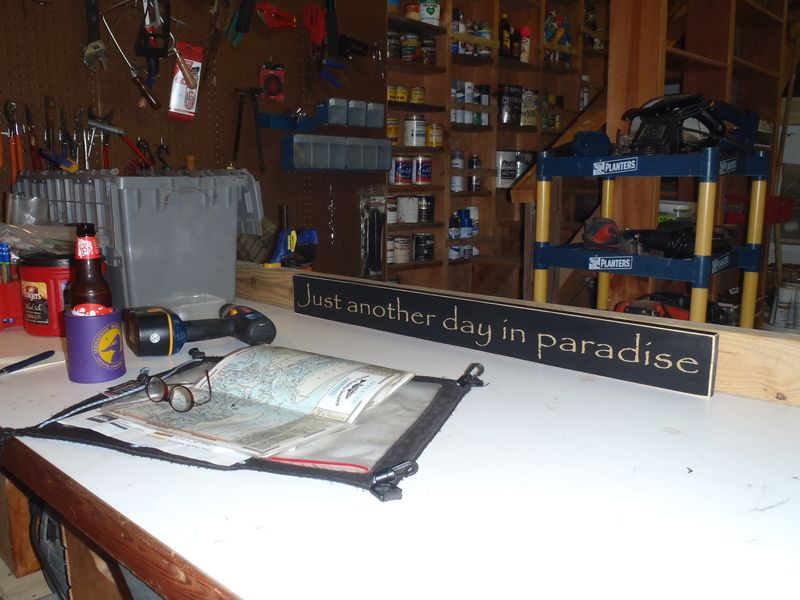
Paddle out to Hammocks Beach State Park/Bear Island once again. Out to one of my favorite paddle-in sites in the mid-Atlantic. The shady and wind protected live oak grove at site #12.
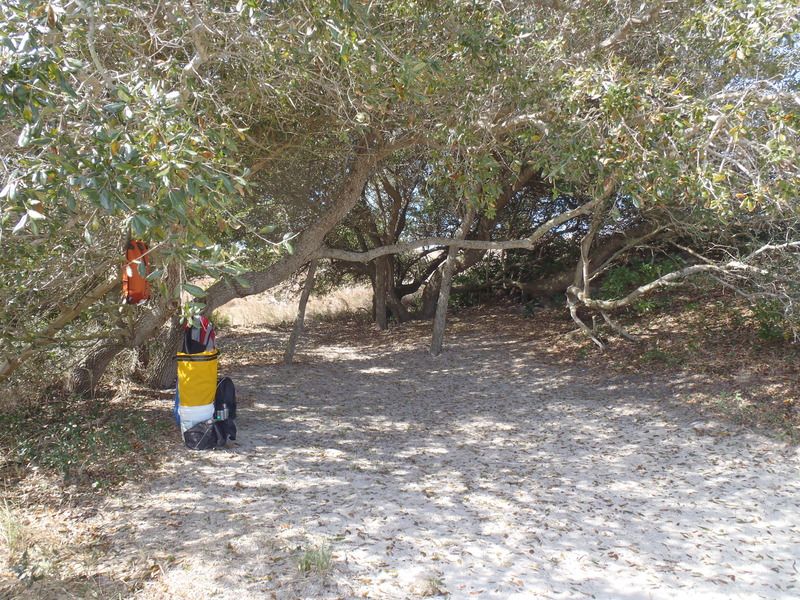
There is nothing handier for tent and pole containment than the full sized wind chair. Stakes in the cup holders, poles and tent body out of the sand.
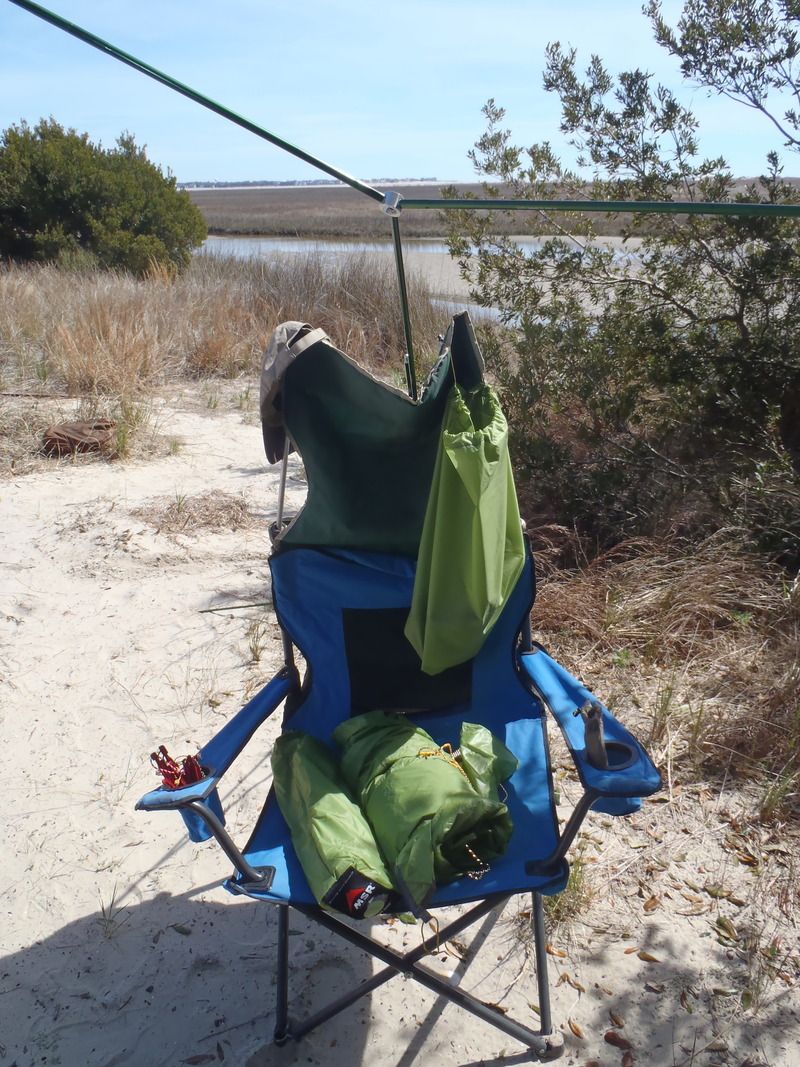
With my abode and day hammock erected it was time for a late breakfast. I had intended to paddle in to Bear Island a week earlier with fortuitous tidal timing, and came in non-stop as a soon as the park opened. Despite that timing I faced the reverse, and coming out to the island against the tide was a work out. I’m hungry.
The new water-heater foil pouch is the insulation freeze-dry meal bomb. Wrapping group cooking pots in that stuff is invaluable in keeping a meal warm, but I don’t cook for more than me. I chowed down on a caloric breakfast burrito and Starbucks Via coffee as I watch the tide change and the early Atlantic flyway migration pass through. A pricey repast, but I’m worth it, and so is the peculiar moon and tide timing.
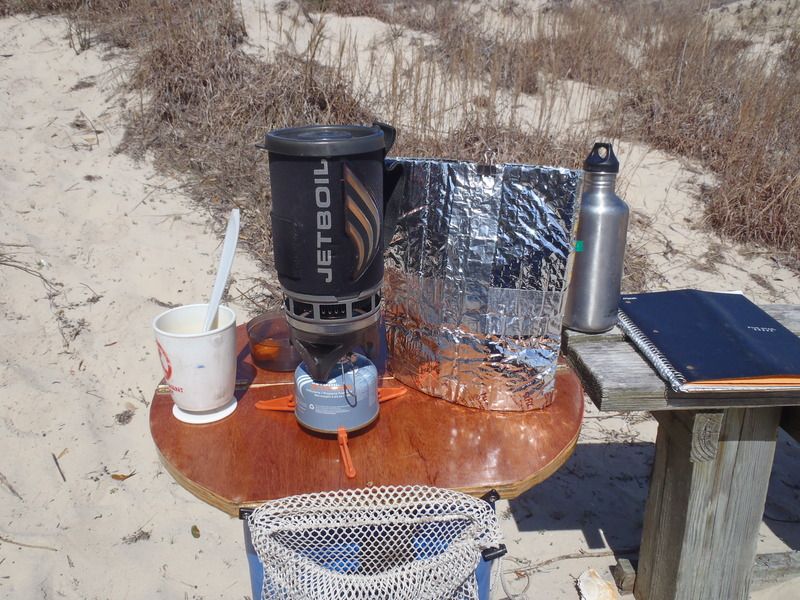
I tried the DIY rudder briefly on the way in, but really didn’t need it going against the tide and had no sailing breeze to push me off shore. Being increasingly tidal backwards I had to wade the canoe across sandbars for the last 100 yards. There is a new moon coming and some big tides. Cool beans, big tides are fun to watch.
I do appreciate the shade and wind shelter of site #12, but the ocean view from the #13 high in the dunes is amazing and in buggy conditions that high and windy exposure might be appreciated.

There followed some of the laziest days ever, laying about in the day hammock, reading books (plural), watching the birdlife in the dense oak branches above me, paddling the remainder of the inland channel and (very shallow) “lake” out to the dozen beachfront paddle in sites.

The beach. Yawn. Screw the boring beach, give me the changeable bayside. Tide going in and out, landscape radically changing, more critters, shade, sun, wind protection and a maritime forest island a short day paddle away.
Add to that a comfy hammock, comfy chair, comfy tent and zero people and some days I didn’t move more than 100 yards from camp. Barrier islands are a wonderful place to sit and let it all come to you.
I had booked site #12 for 5 days ($13 a night), Monday through Friday, even though I had seen a long range forecast for a fugly Thursday afternoon, continuing through all of Friday. I had hopes that might change more favorably.
It didn’t. Thursday dawned with a cloudy portent of rain, and the weather radio predicted worse as the day went on.
I do not like packing up wet, and packing up wet with a hard driving rain splattering sand up onto the sides of everything from tent to packs is just a freaking mess. A mess in the canoe, a mess in the truck, a mess in the gear room at home when everything comes out and be hung to dry.
I packed up while it was still dry, knowing that no matter how I shook the dice I was screwed tidally. I’d like to ride the tide back in with sufficient water depth, maybe catch the middle twelfths for a free ride, but the next high tide is at 7pm. They lock the park gates at 6pm.
Plan B is to paddle out towards dusk with a dry packed camp and surreptitiously commando sleep in the back of the truck ‘til the gates open again at 8am.
Around 10am as the skies got greyer, I was packed up and decided it was time to go. Time to go, dead into the teeth of the outgoing tide. The outgoing new moon tide.
I am only a partial dipshit. I knew that outrushing water would be a tough slog, and that the shallows (and getting shallower) would not afford much paddle purchase. But I had a nice steady 10 mph breeze off the ocean.
Up the Spirit Sail, down the rudder (which, though effective, needs some tweaking) and oh-hell-yeah, that’s the only way to travel, in the shallows or against the tide and especially both. What would have been a tough battle out became mostly a sit and steer.
Paddled out, racked and packed just as the first rain began to spatter down. Oh hell yeah #2, everything stored in the truck dry and sand free.
I thought that such wise decision making deserved a reward, so I stopped off at Saigon Sam’s just outside the Camp Lejune main gate for a military surplus treat and met Sam himself. Got me a nice desert camo fatigue jacket.
http://www.saigonsamsmilitary.com/
Thus passed another month of eastern NC joy, putzing around the inland swamp rivers and coast.
I highly recommend eastern NC for late winter/early spring peregrinations. The NC State Park system does some paddler’s parks very well – Hammocks Beach, Merchants Millpond, Lumber River – and in the shoulder seasons the locals think it is still winter.

I arrived at my home base in the pine barren swamps of NC’s South River to find a more fluid situation. The culvert across the road in is blocked and flooded. I splashed through, unloaded the truck and returned in full-Farmersexual outfit; overalls and muck boots, with saws, rakes, hoes, clippers and other implements loaded into the Gator. With a fair tasty beer.

I gave up four times trying to unplug that dang culvert. And went back 5 times. I got a little drainage going, but the top of the culvert was still 4 feet underwater. I could just barely hook some obstructing piece of metal debris lodged at the culvert opening, which itself took a while to even find, but I couldn’t get the obstruction near the surface.

OK, I gave up five times. That last time I was bushed, utterly defeated and a good 10 steps back to the Gator when…it flushed.
This end of the culvert had been a dribble.

Too freaking cool. I can sit and spend a whole day watching the tide go in and out. Might as well sit a spell and watch the swamp drain. Unlike the tides I may never get that opportunity again. That blocked culvert had flooded and backwatered 50 acres and took a long time to drain. Days.

Entryway passable there followed a few weeks of, well, playing on the farm if you will, with the usual late night (for me that is any time after dark) shenanigans in the shop. The traditional scrap wood birdhouse, puzzled together and constructed using angle-cut scrap wood and zero new saw cuts, except the entry hole. This time even the entry hole was there. My friend Dave never threw away even a tiny scrap of wood, as the lumber building will attest.

Into my farmhand week paddling pal NC Willy came by for a visit and dueling Tacoma sleepover, and we spent some time in the trees.
Spade bit circle drilled through the bark and cambium.

Chiseled oval and inlaid with a semi-precious cabochon.

Add a hose clamp and a little rubber stopper spacer, so the tree has room to grow a natural bezel around the stone, and the growth stresses don’t crack the agate.

Wait a year or three, remove the hose clamp, and wait a few more years. Dig it up, roots and all (the root structure is the coolest part). Wait a few years while it dries. Strip the bark, shape and sand it into whatever it wants to be – walking stick, sculpture, pipe bowl. Prettiest gear shift knob ever on 20 year’s worth of manual transmissions.
Makes for a nice multi-year project.
Beyond draining swamps. constructing scrap wood puzzles and sticking and stoning - in various definitions – there was plumbing, electrical and fence to work to attend to, and betwixt and between farm work even some canoe outfitting. It had for months been too cold at home to do much boatwork, so I brought some with me. Gawd bless a well equipped shop with ample carport space.

A word on the early March weather in eastern NC. In the space of three days I used three different sleeping bags, a zero degree Wiggys, a 20 F down and a 30/50 down flip. It went from dang cold at night

To shorts and tee shirt weather in 3 days.
But, eventually, you can’t keep me down on Maggies Farm no more. Time to pack up gear and plan a trip.

Paddle out to Hammocks Beach State Park/Bear Island once again. Out to one of my favorite paddle-in sites in the mid-Atlantic. The shady and wind protected live oak grove at site #12.

There is nothing handier for tent and pole containment than the full sized wind chair. Stakes in the cup holders, poles and tent body out of the sand.

With my abode and day hammock erected it was time for a late breakfast. I had intended to paddle in to Bear Island a week earlier with fortuitous tidal timing, and came in non-stop as a soon as the park opened. Despite that timing I faced the reverse, and coming out to the island against the tide was a work out. I’m hungry.
The new water-heater foil pouch is the insulation freeze-dry meal bomb. Wrapping group cooking pots in that stuff is invaluable in keeping a meal warm, but I don’t cook for more than me. I chowed down on a caloric breakfast burrito and Starbucks Via coffee as I watch the tide change and the early Atlantic flyway migration pass through. A pricey repast, but I’m worth it, and so is the peculiar moon and tide timing.

I tried the DIY rudder briefly on the way in, but really didn’t need it going against the tide and had no sailing breeze to push me off shore. Being increasingly tidal backwards I had to wade the canoe across sandbars for the last 100 yards. There is a new moon coming and some big tides. Cool beans, big tides are fun to watch.
I do appreciate the shade and wind shelter of site #12, but the ocean view from the #13 high in the dunes is amazing and in buggy conditions that high and windy exposure might be appreciated.

There followed some of the laziest days ever, laying about in the day hammock, reading books (plural), watching the birdlife in the dense oak branches above me, paddling the remainder of the inland channel and (very shallow) “lake” out to the dozen beachfront paddle in sites.

The beach. Yawn. Screw the boring beach, give me the changeable bayside. Tide going in and out, landscape radically changing, more critters, shade, sun, wind protection and a maritime forest island a short day paddle away.
Add to that a comfy hammock, comfy chair, comfy tent and zero people and some days I didn’t move more than 100 yards from camp. Barrier islands are a wonderful place to sit and let it all come to you.
I had booked site #12 for 5 days ($13 a night), Monday through Friday, even though I had seen a long range forecast for a fugly Thursday afternoon, continuing through all of Friday. I had hopes that might change more favorably.
It didn’t. Thursday dawned with a cloudy portent of rain, and the weather radio predicted worse as the day went on.
I do not like packing up wet, and packing up wet with a hard driving rain splattering sand up onto the sides of everything from tent to packs is just a freaking mess. A mess in the canoe, a mess in the truck, a mess in the gear room at home when everything comes out and be hung to dry.
I packed up while it was still dry, knowing that no matter how I shook the dice I was screwed tidally. I’d like to ride the tide back in with sufficient water depth, maybe catch the middle twelfths for a free ride, but the next high tide is at 7pm. They lock the park gates at 6pm.
Plan B is to paddle out towards dusk with a dry packed camp and surreptitiously commando sleep in the back of the truck ‘til the gates open again at 8am.
Around 10am as the skies got greyer, I was packed up and decided it was time to go. Time to go, dead into the teeth of the outgoing tide. The outgoing new moon tide.
I am only a partial dipshit. I knew that outrushing water would be a tough slog, and that the shallows (and getting shallower) would not afford much paddle purchase. But I had a nice steady 10 mph breeze off the ocean.
Up the Spirit Sail, down the rudder (which, though effective, needs some tweaking) and oh-hell-yeah, that’s the only way to travel, in the shallows or against the tide and especially both. What would have been a tough battle out became mostly a sit and steer.
Paddled out, racked and packed just as the first rain began to spatter down. Oh hell yeah #2, everything stored in the truck dry and sand free.
I thought that such wise decision making deserved a reward, so I stopped off at Saigon Sam’s just outside the Camp Lejune main gate for a military surplus treat and met Sam himself. Got me a nice desert camo fatigue jacket.
http://www.saigonsamsmilitary.com/
Thus passed another month of eastern NC joy, putzing around the inland swamp rivers and coast.
I highly recommend eastern NC for late winter/early spring peregrinations. The NC State Park system does some paddler’s parks very well – Hammocks Beach, Merchants Millpond, Lumber River – and in the shoulder seasons the locals think it is still winter.
